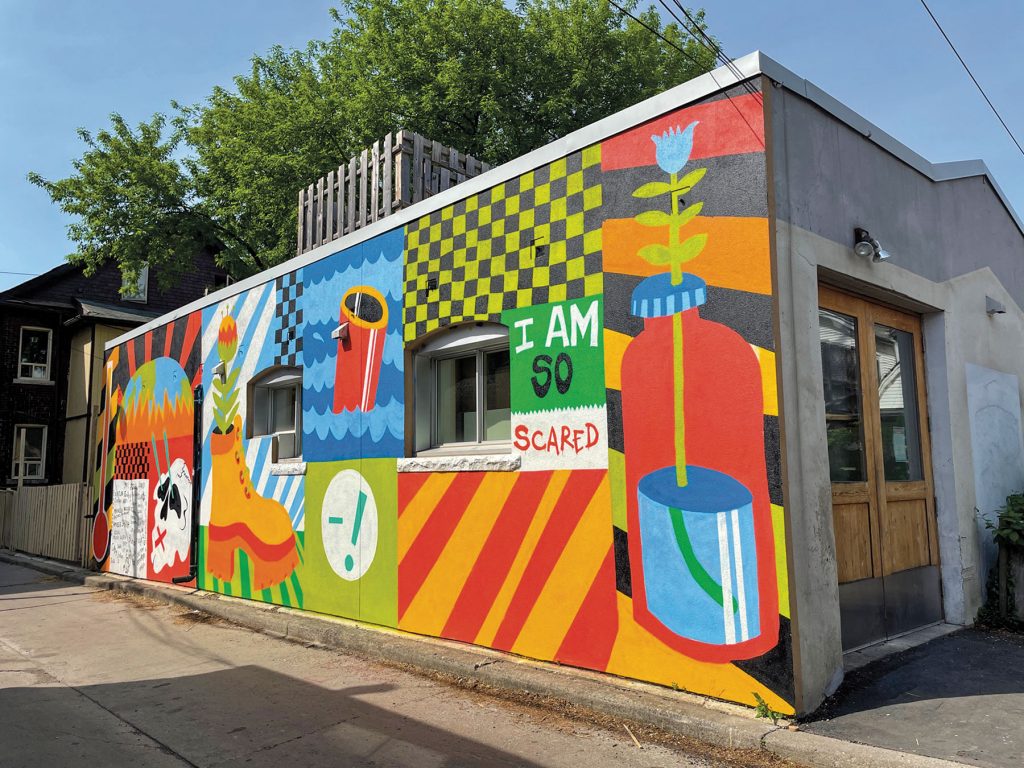Musician Scott Helman’s song Evergreen is basis for images

By Nicole Stoffman
At first glance, the brightly coloured mural in Karma Lane behind Palmerston Avenue appears to be a children’s project. But a closer look reveals it to be a Gen Z manifesto to eco-anxiety: a skull’s empty eyes gaze in terror as the earth is engulfed in flames, a larger-than-life thermometer glows red, and a plastic cup bobs in the ocean waves. “I’m so scared,” are the only words.
Yet this new addition to Annex laneway art is not all doom and gloom, as a happy flower springs forth from inside a trendy, lug-soled work boot. The colour palette evokes orange and pistachio sherbet on a summer day.
“It still offers a message that through change, there’s hope,” said Karma Manager, Talia McGuire. “I really see this as giving young people a platform to be able to voice those concerns and fears.”
The Scott Helman Evergreen mural was created by artist Kayla Buium over five chilly hours in November, 2019. The occasion was the release of Helman’s single “Evergreen,” about climate change. The song expresses the singer’s anxiety about “rising seas and a world on fire,” but concludes with the hopeful thought, “maybe I can make it if we plant seeds in dirt.”
Helman is a Toronto-born singer-songwriter who grew up in North York and attended Earl Haig. He is represented by Warner Music Canada, and his albums have earned three platinum and two gold certifications. He has been nominated for seven Juno awards.
The 25-year-old had invited fans to share their feelings about the climate crisis to use in the “Evergreen” video and was astonished when he received hundreds of responses.
He decided to use his celebrity to amplify these voices with a mural, and has published their testimonials as “The Evergreen Manuscript,” which he is sharing with elected leaders across the globe. He invited fans to attend the live-streamed mural painting, and to sign their names on it.
Is the Evergreen mural effective activism, experiential marketing, or a bit of both?
“It was a genuine, heartfelt action on his part,” said McGuire. “We had lots of conversations inside the store about certain things you can do to help reduce waste.” Helman was impressed by Karma Co-op, which is owned by its 600 members. He has called the only food co-op in Toronto a, “dope, anarchist grocery.”
First identified in 2017, eco-anxiety is defined by the Canadian Mental Health Association as “a deep fear of environmental doom and human catastrophe,” for which doom-scrolling youth are the most at risk. The kinds of actions offered on that day by the Evergreen mural project are recommended by the CMHA as a healthy response: joining others in hopeful activism, and sharing your feelings. Other CMHA recommendations include learning social media literacy and striving for a small environmental footprint, something Helman encourages his fans to do.
The mural painting was supported by the Sierra Club Foundation, Greenpeace Canada, Environmental Defense, We Movement, and The Laneway Project. The Laneway Project is a non-profit social enterprise on a mission to bring Toronto’s 2,400 laneways to life. They connected Helman’s production company with Karma Co-op, whose laneway the Project had helped animate in celebration of Karma’s 45th anniversary in 2017. The Evergreen Mural is the Laneway Project’s third laneway improvement in the Annex, the other’s being Croft Street and Willowvale Lane.
As the Annex becomes more densely populated, its laneways could offer a network of walkable streets. The Laneway Project has installed road murals, street art, and improved lighting, greening, and traffic calming to turn laneways across the city into high quality mixed-use space.
“Laneways are officially mixed-mode spaces,” explained Laneway Project Executive Director Michelle Senayah. “Everyone assumes they are car-only spaces but they’re actually not.” When a laneway hosts block parties or pop-up festivals, it is closed to traffic, but a drive-aisle is always kept free for emergency access.
“Especially in the Annex where there are so many different family structures, living in many different sizes of units, I think there is real potential to add depth to the local public realm by activating this other layer to provide human-scaled outdoor space,” said Senayah.
She adds that laneway housing, especially as it becomes more standardized and therefore affordable, will go a long way to making Annex laneways feel more welcoming.
The Gleaner was shocked and saddened to hear of Michelle Senayah’s sudden passing from a pre-existing health condition on June 29th. Our condolences to her family and colleagues at The Laneway Project.
READ MORE:
- NEWS: Alleyway on the cutting edge (Feb. 2021)
- LIFE: Paying homage to local characters (Oct. 2020)
- NEWS: U of T’s unique laneway homes (Aug. 2020)
- NEWS: New mural for Major (Dec. 2019)
- ON THE COVER: Laneway lit up (October 2018)
- CHATTER: Live from your laneway (Election Special 2018)
- CHATTER: U of T proposes laneway housing pilot on Huron Street(Spring 2018)
- ON THE COVER (JANUARY 2017): Putting the city’s laneways to work
- NEWS (JANUARY 2017): Laneway living
- NEWS (OCTOBER 2016): Preventing a wall of towers
- CHATTER: Painted streets launch in Kensington (SEPTEMBER 2016)
- ARTS: Façade facelift: Lee’s Palace iconic mural is back (Nov. 2010)
